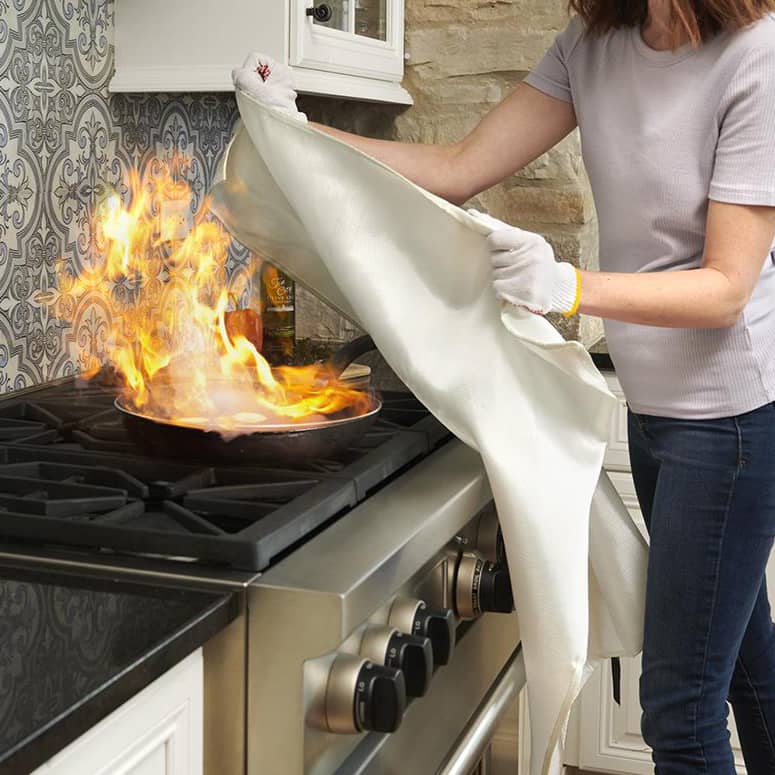Tempe, AZ, 31st October 2025, ZEX PR WIRE, A new 10-year analysis of publicly available U.S. Fire Administration (USFA) data from 2014–2023 indicates that nearly 50% of all reported residential fires in the United States originate in the kitchen, with 167,800 cooking-related incidents recorded in 2023 alone. Despite ongoing public awareness efforts, the data suggest that many households could improve their kitchen fire preparedness.

The data, compiled from the National Fire Incident Reporting System (NFIRS), sindicates that cooking has consistently led all home fire causes for over a decade, remaining higher than incidents caused by heating equipment (27,900 annually) and electrical malfunctions (23,700).
“Many households prioritise smoke detectors and fire extinguishers in garages or hallways,” says fire safety researcher Michael Chen, “yet the kitchen, where most home fires start, often has no readily accessible fire suppression tool.”
Why Kitchen Fires Require Immediate Attention
Cooking fires, especially grease-related incidents, behave differently from other household fires. They ignite quickly, spread rapidly, and should never be extinguished with water, as this can cause flames to intensify and spread burning oil.
Traditional fire extinguishers, while effective in many situations, may not always be practical during kitchen incidents because they:
- Are sometimes stored away from cooking areas
- Require multiple operational steps under stress
- Leave chemical residue that can contaminate surfaces
- Need regular maintenance or replacement
“In the first moments of a kitchen fire, accessibility and simplicity are key,” explains Michael Chen. “When a fire suppression tool isn’t immediately within reach, even a small ignition can escalate before help is applied.”
The Case for Fire Blankets: An Accessible Kitchen Safety Option
Fire safety experts often recognise fire blankets as the first line of defence in kitchens.
How they work: Fire blankets extinguish flames by cutting off oxygen, smothering the fire quickly without chemicals, noise, or residue.
Key advantages:
- Instantly deployable – just pull and cover
- Mountable near the stove for immediate access
- Safe for all types of kitchen fires (including grease)
- Leave no residue or contamination
- No maintenance or expiry issues
- Safe for anyone to use, even children or seniors
“The strength of a fire blanket lies in its simplicity,” says Chen. “It’s easy to use and requires no special training.”
Who’s Most at Risk
According to USFA data, cooking fires affect all demographics, but certain situations heighten the risk:
- Unattended cooking (the leading cause)
- Holiday or late-night cooking
- Deep frying and multitasking
Every year, 2,620 civilians die in home fires, with seven deaths daily and 92% occurring in residential settings. Many of these stem from preventable cooking incidents.
The Fiberglass Issue: A Hidden Safety Hazard
While fire blankets are lifesaving tools, many contain fiberglass may present potential health concerns. When deployed, fiberglass blankets can shed tiny airborne particles that irritate skin and lungs and contaminate kitchen surfaces.
“It’s ironic,” says occupational health specialist Dr. Sarah Martinez, “that a device meant to release fine particles that may affect indoor air quality, especially in homes with children, elderly, or asthmatic individuals.”
The Safer Alternative: Fiberglass-Free Fire Blankets
Newer, fiberglass-free fire blankets eliminate these health concerns while maintaining full fire suppression performance.
Fire Blanket Safety, a U.S.-based company pioneering this innovation, offers the market’s only certified fiberglass-free fire blanket using advanced non-shedding, fire-resistant materials.
Benefits of fiberglass-free blankets:
- No airborne fibers or respiratory irritation
- Safe for food-prep areas
- Reusable and durable
- No maintenance or expiration concerns
- Effective on grease, electrical, and general fires
“The technology finally matches the need,” says Fire Blanket Safety’s development team. “Families can now protect themselves instantly without compromising air quality or health.”
Beyond the Kitchen: All-Purpose Protection
Fire blankets are also effective for:
- Heating equipment fires: Quickly smother space heater ignitions
- Electrical fires: Safe alternative where water is dangerous
- Accidental fires: Candles, smoking materials, or small ignition sources
What Fire Safety Experts Recommend
To improve home fire preparedness, experts suggest a layered approach:
In the Kitchen:
- Install a fire blanket within arm’s reach of cooking areas
- Keep a fire extinguisher nearby as backup
- Never leave cooking unattended
For Whole-Home Safety:
- Smoke detectors on every floor
- Fire blankets in kitchen, garage, and workshop
- A clear family evacuation plan
“Each layer serves a purpose,” says Chen. “Blankets handle small fires instantly, extinguishers back them up, and detectors provide early warning.”
Taking Action: Key Questions for Homeowners
How quickly can you access fire suppression tools from your stove?
- Are your safety devices appropriate for grease fires?
- Do your tools pose any health risks?
- Can every family member operate them confidently?
Experts emphasise proximity, simplicity, and safety as the three essentials of kitchen fire readiness.
The Bottom Line
Public NFIRS data indicates that nearly half of all U.S. home fires start in the kitchen, highlighting the importance of accessible fire-safety tools. Fire blankets, especially fiberglass-free versions—offer a safe, immediate, and cost-effective solution for the most likely fire kitchen emergency.
“We can’t prevent all fires, but we can be prepared,” concludes Dr. Martinez. “Having a fire blanket in your kitchen isn’t optional, it’s essential.”
About the Data:
All data referenced are from publicly available NFIRS reports issued by the U.S. Fire Administration.
Media Contact:
Fire Blanket Safety
Website: fireblanketssafety.com
Disclaimer: The views, suggestions, and opinions expressed here are the sole responsibility of the experts. No Echo Gazette journalist was involved in the writing and production of this article.
